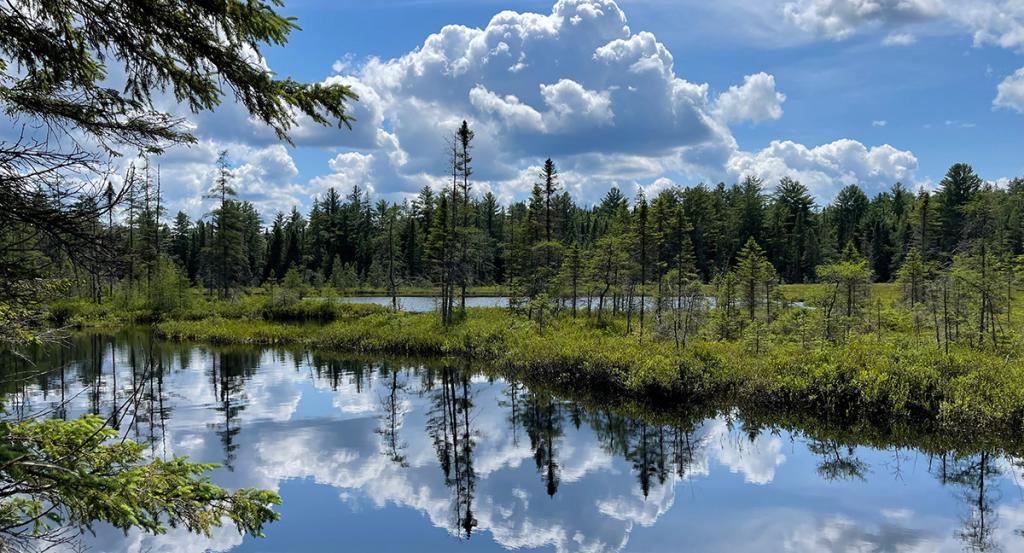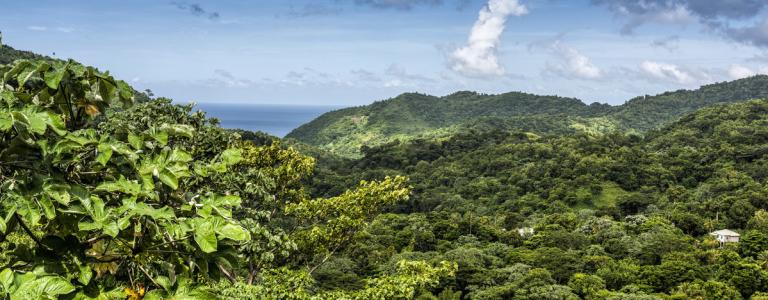Advancing Biodiversity-Positive Nature-Based Climate Solutions
Climate change serves as a threat multiplier, amplifying biodiversity loss and ecosystem degradation globally. As a result, advancing climate solutions that preserve and restore ecosystems is critical. Actively conserving our forests, wetlands, oceans, and coasts will help communities become more resilient to the impacts of climate change. Nature-based solutions (NbS) for climate change adaptation can be a cost-effective way to increase resilience while generating multiple benefits (or co-benefits) for nature and society. But achieving measurable gains for biodiversity functioning that also deliver wins for society and adaptation often proves to be challenging.
The International Institute for Sustainable Development’s (IISD’s) recent report, Enhancing Biodiversity Co-Benefits From Nature-Based Solutions, provides recommendations to help plan, design, and implement NbS for adaptation that enhance biodiversity and ecosystem integrity. These recommendations range from incorporating Traditional Knowledge of biodiversity and ecosystem services and using cost-effective indicators for monitoring, evaluation, and learning to integrating local values that will help ensure that benefits address the needs of local community members.
Concrete examples of biodiversity co-benefits achieved through the implementation of NbS exist. From India to Ethiopia to Canada, we explored some of them at a recent event hosted by the Aga Khan Foundation Canada, IISD (under the Nature for Climate Adaptation Initiative), and Global Affairs Canada. These three case studies provide valuable examples of NbS’ potential while showing the versatility of NbS for different contexts.
Enhancing the Resilience of Coastal Communities in India
In recent years, natural hazards on the Saurashtra coast of Gujarat in India have become increasingly frequent. Exacerbated by climate change, phenomena such as cyclones, storms, coastal erosion, sea level rise, heat waves, floods, and extreme rains have been intensifying. To adapt to these changes, 20 coastal villages in the Porbandar district have partnered with the Aga Khan Agency for Habitat and technology company Ericsson to enhance their resilience through an ecosystem-based and community-centred approach.
Community members are planting 100,000 mangroves and other plant species to restore the coastal ecosystem and protect against coastal erosion adjacent to villages and nearby areas. Mangroves have proven efficient in mitigating the effects of storm surges, soil erosion, and salinity, as well as soaking up the carbon dioxide that contributes to climate change. Furthermore, cloud-based artificial intelligence monitoring sensors used in the project generate real-time data on the mangroves and coastal restoration efforts. With this project, new climate-resilient livelihood opportunities will arise for local communities—for example, they will plant 20,000 fruit-bearing trees across 10 villages to help increase biodiversity and reduce local heat waves.
Anita Miya, Head, Knowledge Management and Partnership, Aga Khan Agency for Habitat, provides more information in her presentation.
Improving the Health, Profitability, and Adaptability of Ethiopian Coffee Farmers
Ethiopia is one of the most climate-vulnerable countries in the world due to its strong reliance on rain-fed agriculture and natural resources and its limited ability to adapt to the changing climate. As explained by Anil Gupta, Senior Environment Specialist at Global Affairs Canada, a quarter of the population (mostly small-scale female farmers) derive their livelihoods from the production, processing, and marketing of coffee. However, with increasing temperatures and high inter-annual and intra-seasonal rainfall variability, areas suitable for wild coffee production could shrink by 40% to 90% by 2040.
Another issue, specific to the Sidamo region in southern Ethiopia, is how to deal with coffee processing wastewater. According to an early case study presented by Gupta and Paul Stewart, TechnoServe, 2 billion litres of hazardous wastewater is produced annually, overflowing into rivers and impacting human and animal health. The Sidamo project took different NbS measures to tackle this problem, including
- composting the waste pulp from coffee processing,
- installing over 100 vetiver grass restoration initiatives around wetlands, and
- planting over 1 million indigenous shade trees on 28,000 smallholder coffee farms (to protect the soils and the coffee trees from heat and retain soil moisture).
(Through the project) I learned that coffee trees have a shorter lifespan when grown under full sun and reduce the coffee yields. That is why I loved to plant trees on my farm, as it, in turn, leads me to live a comfortable life.
As a result, both the river water quality and the climate resilience of small-scale coffee farmers in the Sidamo region have improved over the past 10 years.
Restoring, Protecting, and Connecting Natural Landscapes Across Southern Canada
Southern Ontario contains the highest diversity and density of species in Canada, explained Janet Sumner, Executive Director, Wildlands League. The region is home to approximately 200 endangered species—out of a total of 500 endangered species in the country—and 80% of the species at risk in the province. To address both the extinction crisis and the climate emergency, the Nature Connectivity Project brings together protected area initiatives on both public and private lands under the Southern Ontario Nature Coalition and aims to integrate these parcels of land into the Rouge National Urban Park, enlarging it by 30%.
An important piece of the connectivity puzzle is the Ontario Greenbelt, which is composed of 800,000 hectares of farmland and natural areas around the Greater Toronto Area that are currently protected from urban sprawl. It provides multiple benefits, such as offering spaces for outdoor activities, alleviating the impacts of climate change, and countering biodiversity loss. But a rapidly growing population and their housing and transportation needs are threatening the integrity of this space. It will only endure if we find ways to recognize and preserve viable ecological connections among a web of green spaces—namely for fauna to safely migrate to and from larger protected areas.

The Nature Connectivity Project enables just that as it aims to achieve an interconnected network of protection and ecological corridors across Southern Ontario, with positive mitigation and adaptation benefits for 12 million people. Among the multiple benefits, the project will create jobs, protect communities from flooding, and deliver on biodiversity co-benefits, including protecting a rare Carolinian forest that hosts over 1,700 species of plants and animals—23 of which are at risk.
Working Together to Scale Up NbS for Adaptation
If our communities and ecosystems are going to work together to survive these modern crises, we will need to increase evidence-based, inclusive, impactful, and gender-inclusive NbS for adaptation and biodiversity worldwide. This is what the Nature-Based Solutions (NbS) for Climate and Biodiversity Community of Practice aims to do by allowing organizations across the world to share their insights, expertise, and networks—as seen with the case studies above that were presented in the same meeting to cover a variety of perspectives and NbS practices.
Furthermore, Stefan Ruge and Michael Opitz from the German foundation Hanns R. Neumann Stiftung along with Kevin West from popular coffee chain Tim Hortons shared findings from a collaborative project on coffee and climate change adaptation. In addition, Jerry Nwigwe from the youth-led association Debate and Development Resource Centre–Nigeria discussed the integration of an NbS approach applied to a cassava value chain.
Nicholas Macfarlane, International Union for Conservation of Nature, also introduced to the Community of Practice the Species Threat Abatement and Recovery (STAR) metric, which measures the potential of “particular actions at specific locations to contribute to global sustainability targets, supporting science-based targets for species biodiversity.” It is a spatially explicit and standardized way of measuring biodiversity that allows a range of stakeholders, from policy-makers to NbS project teams, to compare the potential biodiversity impacts of specific actions.
Any organizations interested in NbS for adaptation and biodiversity are welcome to join the Community of Practice and can email PartenairesClimatPartners@international.gc.ca for more information.
The initial work plan of the NbS for Climate and Biodiversity Community of Practice was co-developed by Global Affairs Canada, members of the Canadian Coalition on Climate Change and Development, and other organizations in Canada.
The event From Knowledge to Practice: Advancing Biodiversity-Positive Nature-Based Climate Solutions was organized as part of the Aga Khan Foundation Canada’s Speaker Series on Climate Resilience and Adaptation. All presentations from the event can be found here. Don't miss our upcoming event, From Knowledge to Practice: Mainstreaming Gender Equality and Social Inclusion in Nature-Based Solutions for Adaptation, on 19 October 2023.
Relevant resources are also available on the Nature-based Infrastructure Global Resource Centre.
You might also be interested in
Seeking Clarity on Nature-Based Climate Solutions for Adaptation
This guidance note clarifies the concepts behind nature-based solutions (NbS), nature-based climate solutions (NBCS), and ecosystem-based adaptation (EbA).
Seeking Common Ground for Climate, Biodiversity, and People: How to get the debate on nature-based solutions right
To protect ecosystems and people, we must learn from past mistakes and work together on inclusive and robust nature-based solutions.
Scaling up Nature-Based Infrastructure for People and Planet
Nature-based infrastructure can help us deal with climate change and build a better future for communities worldwide
Building the Investment Case for Nature-Based Infrastructure
Nature-based infrastructure help increase societies' resilience to climate change and the insurance industry can play a key role.

